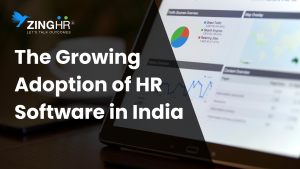Payroll is one of the most important parts of any business, it affects employee satisfaction, compliance and the overall health of the company. When payroll runs smoothly employees feel valued and secure and that contributes to a positive culture and higher retention. When payroll goes wrong (delays or errors) it erodes trust, reduces productivity and can even lead to fines or legal complications.
With the rapid development of payroll technology, there are many options available in the market today, from manual to cloud-based solutions. Each payroll system has its own features and benefits suited for different business sizes and industries, so decision-makers need to know which one is required.
For small businesses simplicity and affordability might be the top priority while larger corporations might look for advanced features like automated tax filing, integration with other HR systems and remote access.
This guide will help you through that. Whether you’re a small business owner, HR manager or company executive understanding the different types of payroll systems will enable you to make a decision that is efficient, compliant and supports your business growth.
We’ll go through the different types of payroll systems, their pros and cons and use cases so you can decide what’s best for your business.
What is Payroll Outsourcing?
Payroll outsourcing is the process of hiring a third-party company to handle the administration of employee salaries, wages, bonuses, and deductions. This includes tasks such as calculating and distributing paychecks, withholding and remitting taxes, and maintaining payroll records.
Payroll outsourcing services are becoming increasingly popular among businesses of all sizes. By outsourcing payroll, companies can save time and money, reduce the risk of errors, and ensure compliance with local and federal regulations. In this article, we will examine various types of payroll outsourcing services available and help you determine the one which is right for your business.
8 Types of Payroll Systems: Pros, Cons and Examples
1. Cloud-Based Payroll Systems (Online Payroll)
Another type of outsourced payroll service is virtual payroll. This type of service is ideal for businesses that have employees working remotely or have a decentralized workforce. With virtual payroll, the payroll provider handles all aspects of payroll administration, including compliance and tax-related tasks. This type of service is often less expensive than full-service payroll, as the business is only paying for the services they need.
Pros: Accessible from anywhere, automatic updates, scales with business growth, time-saving, etc.
Cons: Monthly or annual subscription fees.
Best for: All businesses, especially for enterprise businesses.
For example, A tech startup with remote employees uses an online payroll system to pay employees globally. Employees can access their payslips online and the system does the tax updates so no manual intervention is required.
2. In-House Payroll Software
In-house payroll software is a digital solution that businesses manage on their own. It can be cloud-based or on an internal server, giving total control over payroll data. Also, it automates repetitive tasks and reduces human error compared to manual systems.
Pros: Increased accuracy, data privacy, more control.
Cons: Requires training and software updates, often higher initial cost.
Best for: Small to medium-sized businesses with complex payroll structure.
For example, A mid-sized consulting firm uses in-house payroll software to handle its diverse pay grades and incentive structures. The system has reduced calculation errors and pays efficiently, but it incur costs for software maintenance and periodic training.
3. Manual Payroll Systems
A manual payroll system involves payroll calculation using basic tools like spreadsheets, excel, pen and paper or calculators.
Some small businesses still use manual payroll for its simplicity and low budget. However, this method requires a lot of time and room for human error. Also, It puts a heavy burden on business owners or HR staff to stay updated with tax and compliance.
Pros: Low cost, total control over calculations
Cons: High risk of error, time-consuming, hard to scale.
Best for: Very small businesses with limited employees and a simple pay structure.
For example A small cafe with 5 employees using spreadsheets to manage their payroll. While this approach saves software costs, it requires frequent checks for accuracy and each tax update demands time-consuming adjustments.
4. International Payroll Outsourcing
International payroll outsourcing is a type of payroll outsourcing that is specifically designed for businesses with employees in multiple countries. With this service, the payroll provider handles all aspects of payroll for employees in different countries, including calculating and withholding taxes, processing employee deductions, and issuing paychecks or direct deposits. International payroll outsourcing also includes compliance and reporting, such as filing employment taxes, providing year-end forms, and so on.
International payroll outsourcing is a good option for businesses that have employees in multiple countries and want to ensure compliance with local and federal regulations. It also helps businesses save time and money by handling the complexities of international payroll.
Pros: Ensures compliance across borders, and simplifies global payroll management.
Cons: High cost, complexity and may need specialized support.
Best for: Multinational companies with employees in multiple countries.
For Example, A software company with employees in the US, Europe and Asia uses an international payroll solution to pay employees in local currencies and comply with each country’s tax regulations. The system provides centralized payroll management so global operations can run smoothly.
5. Full-Service Payroll Outsourcing
Full-service payroll outsourcing is the most comprehensive type of payroll outsourcing. With this service, the payroll provider handles all aspects of payroll, including calculating and withholding taxes, processing employee deductions, and issuing paychecks or direct deposits. Full-service payroll outsourcing also includes compliance and reporting, such as filing employment taxes, providing year-end forms and so on.
One of the main benefits of full-service payroll outsourcing is that it takes the burden of payroll off of the business owner or manager. They can focus on other important aspects of the business without worrying about payroll compliance and administration. Additionally, full-service payroll outsourcing providers usually have a team of experts on staff who are up to date on the latest regulations and can ensure compliance.
Pros: Offers expertise, and focus on core business functions.
Cons: Higher cost, Less control, managed by an external provider.
Best For: Large companies, high level of compliance management.
For example, A global company with staff across multiple countries uses a full-service payroll provider to keep updated with local tax laws, currency exchange and cross-border payroll.
6. Self-Service Payroll Outsourcing
Self-service payroll outsourcing is a more hands-on approach to payroll outsourcing. With this service, the payroll provider gives the business access to a web-based platform where they can enter employee information, process payroll, and access reports. The payroll provider still handles compliance and reporting, but the business is responsible for inputting employee information and processing payroll.
Self-service payroll outsourcing is a good option for businesses that have a small number of employees and want more control over the payroll process. It also allows businesses to have access to their payroll information at any time. However, it is important to note that self-service payroll outsourcing still requires the business to have knowledge of payroll regulations and compliance to ensure everything is done correctly.
Pros: reducing HR workload, Employees can input their own information
Cons: Employee training to minimize errors, Limited support.
Best For: Small to medium-sized businesses, tech-savvy workforce, handling basic payroll tasks
For example, A small business uses a self-service payroll system where employees enter their hours and track time off themselves, so the small HR team can focus on recruitment and development.
7. Partial Payroll Outsourcing
Partial payroll outsourcing is a mix of full-service and self-service payroll outsourcing. With this service, the payroll provider handles some aspects of payroll, such as compliance and reporting, while the business is responsible for other aspects, such as entering employee information and processing payroll.
Partial payroll outsourcing is a good option for businesses that want the benefits of outsourcing payroll but still want to maintain some control over the process. For example, a business may choose to outsource compliance and reporting but handle payroll processing in-house. It also allows businesses to have access to their payroll information at any time.
Pros: flexibility, Reduced payroll complexity, Lower cost
Cons: Require additional internal payroll resources
Best For: Medium-sized businesses, compliance or tax reporting.
For example, A retail business across the country outsources tax filing and compliance to an external provider and does payroll in-house to control costs and get specialized compliance support.
8. Outsourced Payroll Services
Outsourced payroll services involve hiring a third party to handle all payroll processes. This is popular with companies that want to delegate payroll and ensure compliance and accuracy without having to have in-house expertise. Outsourced services cover all payroll calculations, deductions, and filings with government agencies, which saves time but costs money.
Pros: Reduces admin workload, ensures compliance, and is good for complex payrolls.
Cons: Less control, more cost, reliable on a third party.
Best for: Medium to enterprise businesses or companies, multi-state or international payrolls.
For Example, A large retail company with over 1,000+ employees outsources its payroll to ensure tax compliance across multiple states. The payroll service provider handles tax filings, employee queries, and compliance reporting, and allowing the HR team to focus on strategic tasks.
Comparison Table of Types of Payroll Systems
| Payroll System | Pros | Cons | Best For |
|---|---|---|---|
| Full-Service Payroll Outsourcing | Comprehensive service, compliance management, saves time | Higher cost, less control | Large businesses with complex payroll needs |
| Self-Service Payroll Outsourcing | Cost-effective, reduces HR workload | Limited support, requires employee training | Small to medium-sized businesses |
| Partial Payroll Outsourcing | Flexible, specific payroll tasks outsourced | Requires internal resources, possible integration issues | Businesses needing support with specialized payroll tasks |
| International Payroll Outsourcing | Compliance in multiple countries, streamlined global payroll | High cost, potential time zone issues | Businesses with a global workforce |
| Manual Payroll Systems | Low initial cost, full control over payroll | Time-consuming, prone to human error | Very small businesses or startups |
| In-House Payroll Software | High control, one-time cost, secure | Requires in-house expertise, may need updates | Mid to large businesses with internal HR |
| Cloud-Based Payroll Systems | Accessible anywhere, auto updates, scalable | Requires internet access, monthly subscription costs | Remote teams, growing businesses |
| Outsourced Payroll Services | Expertise on demand, assured compliance, minimal HR involvement | Less customization, data security concerns | Businesses prioritizing cost and time efficiency |
Key Factors to Consider When Choosing a Payroll System
Selecting the right payroll system for your business is a big decision that affects not just the efficiency of your operations but also employee happiness, tax compliance and overall business performance. Before committing to a particular solution, you need to consider the various factors that align with your business goals, budget and specific payroll needs.
Here’s a more detailed breakdown of the key factors to consider:
1. Company Size and Growth Plans
Company size plays a big role in determining which payroll system is right for you. Different payroll solutions are designed for businesses with different workforce sizes, complexity and level of support needed. Whether you’re just starting out or already managing a large enterprise, choosing payroll software that fits your company’s size and growth plans is key to efficiency and long-term success.
Small Businesses (1-50 employees):
With 1 to 50 employees payroll systems don’t need to be complicated. At this stage business owners often prioritise simplicity, cost and ease of use over features.
Medium Businesses (51-500 employees):
Medium-sized businesses need more advanced functionality to manage more complex pay structures, tax calculations and other benefits. Cloud-based or hybrid payroll systems with automation and employee self-service features may be ideal for growing businesses.
Large Enterprises (500+ employees):
Large companies need a robust payroll solution that can handle mass payroll processing, multiple locations and complex benefits and compensation plans. A dedicated, scalable solution like outsourced payroll services or international payroll systems may be needed.
As you choose your payroll system, think about your business’s growth plans. Will your payroll system grow with your business? Some systems allow you to add more features or employees as your business expands while others may require you to move to a different platform altogether.
2. Payroll Complexity
It is a level of difficulty in processing payroll within an organisation. Payroll systems can be very different depending on the number of employees, compensation packages, benefits, bonuses, tax and compliance requirements. Businesses need to assess their payroll complexity to determine the best payroll system to handle all these intricacies.
The Key factors influencing payroll complexity include:
Employee Types:
Do you have salaried employees, hourly employees, contractors, freelancers, or a mix of all? Managing diverse pay structures is a common challenge. Choose a system that can handle multiple pay types and schedules.
Bonuses and Overtime:
If your business provides bonuses, commissions, or overtime pay, ensure your payroll system can accurately accommodate these types of earnings and deductions.
Benefits Administration:
If you offer benefits like health insurance, retirement plans, or stock options, the payroll system should be able to integrate these benefits smoothly into the payroll process and track deductions.
For businesses with more straightforward payroll, manual systems or basic in-house software may suffice. However, if your payroll includes complex benefits or multiple pay rates, you’ll want to look at solutions that provide automation and customization to handle these intricacies.
3. Compliance and Tax Requirements
Any business finds it challenging to keep up with tax laws and comply with local, state, and federal regulations. The right payroll software should reduce the risk of errors and keep your business compliant with tax and labor laws.
Here’s what to consider
Tax Filing:
Your payroll system should be able to calculate and file taxes for your business location. Federal, state and local taxes: income tax, social security and unemployment taxes.
Labor Laws:
Labor laws differ from country to country, state to state and sometimes even city to city. Your payroll system must keep up with these changing regulations so you don’t violate minimum wage laws, overtime rules or paid leave requirements.
Reporting:
A good payroll system provides reports that can be used to track tax deductions, bonuses and employee benefits for auditing purposes. It should also generate year end reports (e.g. W-2s, 1099s) and e-file taxes.
Make sure the platform is updated to reflect tax rate changes, deductions and compliance rules. Automated compliance reduces research time and errors that can result in penalties.
4. Data Confidentiality
Payroll systems hold sensitive information like employee personal details, tax info, onboarding documents and bank details. So make sure your payroll system is secure and employee data is protected is a key to building trust and avoiding legal issues.
Consider these when evaluating a payroll system:
Data Encryption:
The payroll system should have encryption to prevent hackers or unauthorized access of sensitive data.
User Permissions:
Make sure you can set access controls so only authorized people can access payroll data.
Backup and Recovery:
Have a backup system in place in case of data loss or corruption and disaster recovery options.
5. Employee Self-Service
Payroll systems should be easy to use for both HR and employees. The easier HR can use it, the less time is spent on payroll and more efficient overall. The system should also have self-service options for employees to access payslips, and tax info and update personal details.
For HR Staff:
HR get a lot out of an efficient payroll system, it streamlines their work and reduces manual errors and administrative burden. Payroll systems automate complex calculations, tax withholdings and benefits administration, so HR can do payroll accurately and on time. They can track employee hours, manage overtime and calculate bonuses, commissions and deductions that are applied correctly.
For Employees:
Employees can see their pay stubs, track time and review benefits all in one place. The self-service portal helps them to manage their payroll information and don’t have to ask HR for pay details or benefit deductions. Accurate and timely payroll processing also boosts morale as employees feel valued and fairly paid for their work.
Future Trends in Payroll Systems
1. Automation and Artificial Intelligence (AI) Integration
AI is changing payroll processing by taking out repetitive tasks, reducing human errors and increasing overall efficiency. AI-powered payroll systems can predict errors, detect anomalies in payroll data and ensure tax compliance.
With machine learning algorithms payroll systems can adapt to individual employee situations and offer personalized solutions that improve accuracy and speed.
Impact: Faster processing, less manual errors and more accurate tax and compliance calculations.
Example: AI tools can auto-generate payroll reports, flag inconsistency and auto-update tax tables to match regulatory changes.
2. Blockchain for Enhanced Security and Transparency
Blockchain is slowly making its way into payroll systems because of its ability to provide secure, transparent and immutable records. This blockchain technology decentralized ledger system that secures payroll data, encrypt and protect sensitive information like employee banking and tax details, etc. It can also simplify global payroll providing instant, transparent cross-border payments without intermediaries.
Impact: Better data security, reduced fraud risk and simpler global payroll management.
Example: A company with a global workforce can use blockchain to make timely, secure international payments and avoid long transaction processes.
3. Data Analytics for Strategic Insights
New payroll systems are now offering data analytics tools so businesses can use payroll data for insights. By looking at trends in employee attrition turnover, absenteeism, overtime and payroll costs businesses can make better decisions on workforce planning and resource allocation.
Payroll analytics also allows HR teams to get ahead of issues like high turnover rates or departmental pay discrepancies.
Impact: Better decision-making, workforce planning, issue resolution and labour costs.
Example: A business uses payroll analytics to identify the departments with high overtime costs and adjusts staffing to reduce costs and avoid burnout.
4. Compliance Management and Regulatory Updates
payroll systems are added compliance management tools that automatically update with local, state and federal regulations.
So you can stay compliant with minimal human intervention as compliance gets more complicated with global and gig economy workers. Payroll systems that update in real time to new regulations will protect you from legal issues and penalties.
Impact: Reduced risk, more accuracy, faster payroll.
Example: A payroll system that auto updates with tax law changes means you don’t have to track legislative changes manually.
Conclusion
In conclusion, there are several different types of outsourced payroll services available, each with its own benefits. Full-service payroll is ideal for businesses that don’t have the resources or expertise to handle payroll in-house. Self-service payroll is ideal for businesses that have the resources and expertise to handle some aspects of payroll in-house but need assistance with compliance and tax-related tasks. International payroll is ideal for businesses that have employees working in different countries. And virtual payroll is ideal for businesses that have employees working remotely or have a decentralized workforce. By exploring the different types of outsourced payroll services, businesses can find the one that best suits their needs and budget.
By outsourcing payroll services, businesses can save time and resources while ensuring compliance with government regulations. The different types of outsourced payroll services offer a range of benefits, including full-service payroll, self-service payroll, partial payroll, international payroll and virtual payroll. Each type of service is tailored to meet the unique needs of a business, and by exploring the options available, businesses can find the one that best suits their needs and budget.




